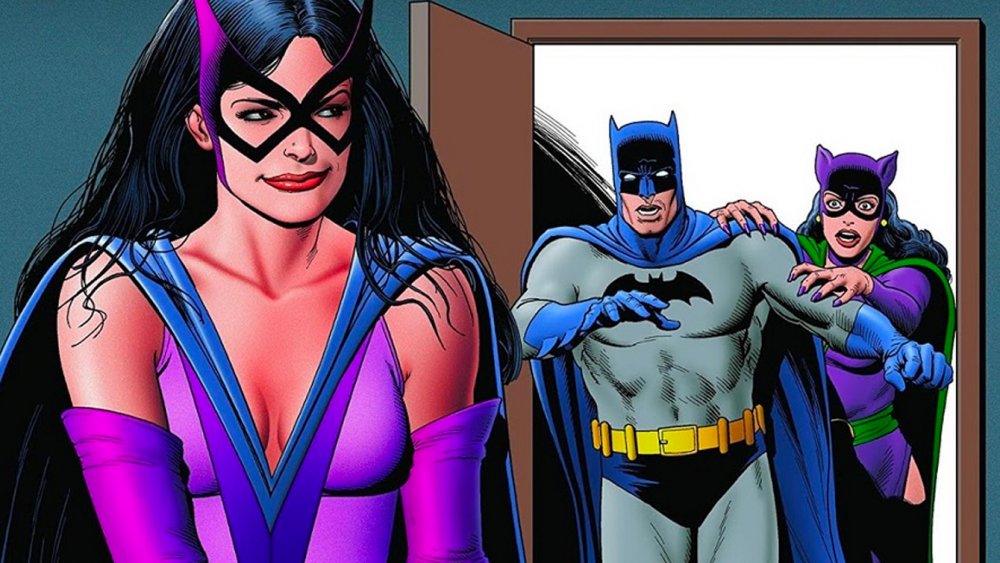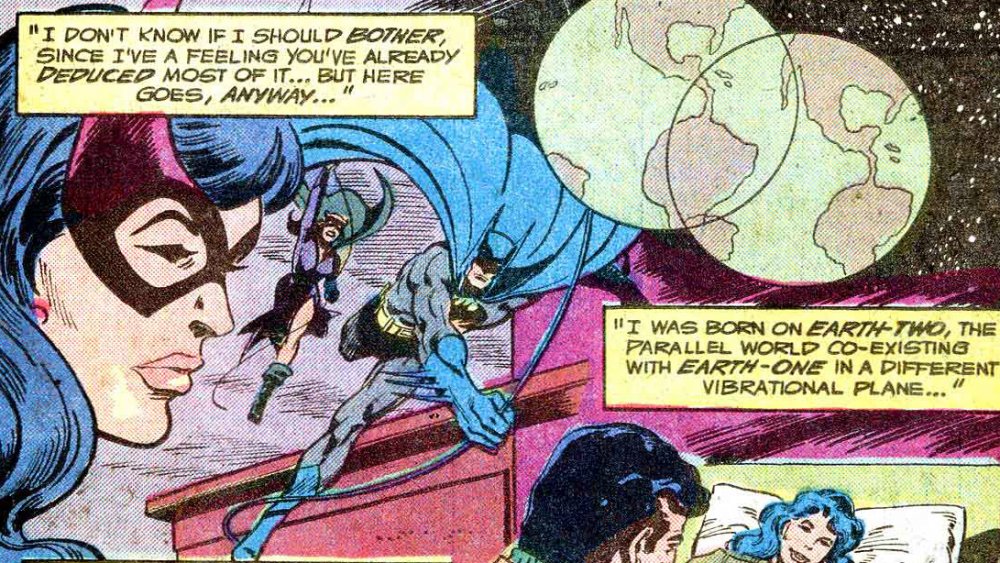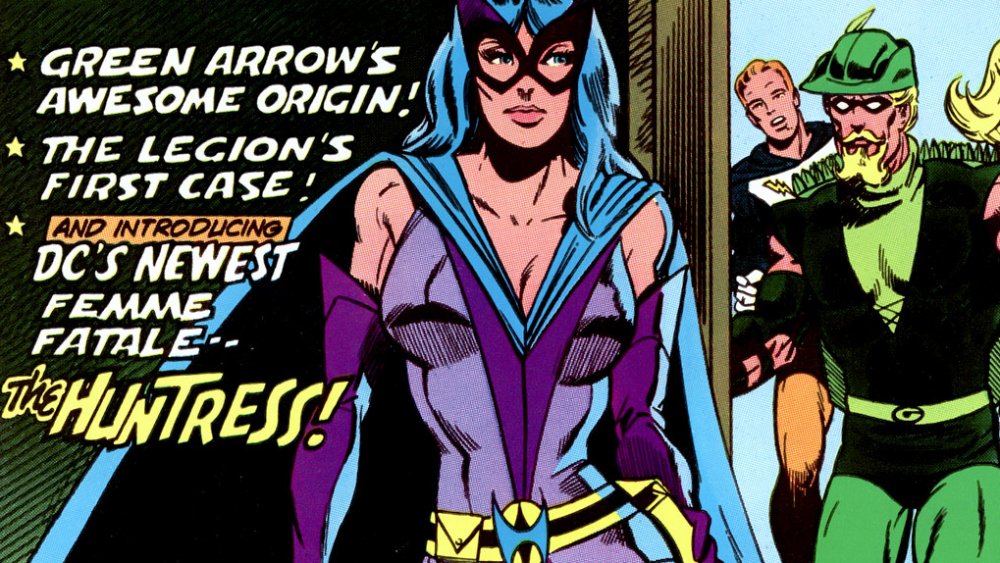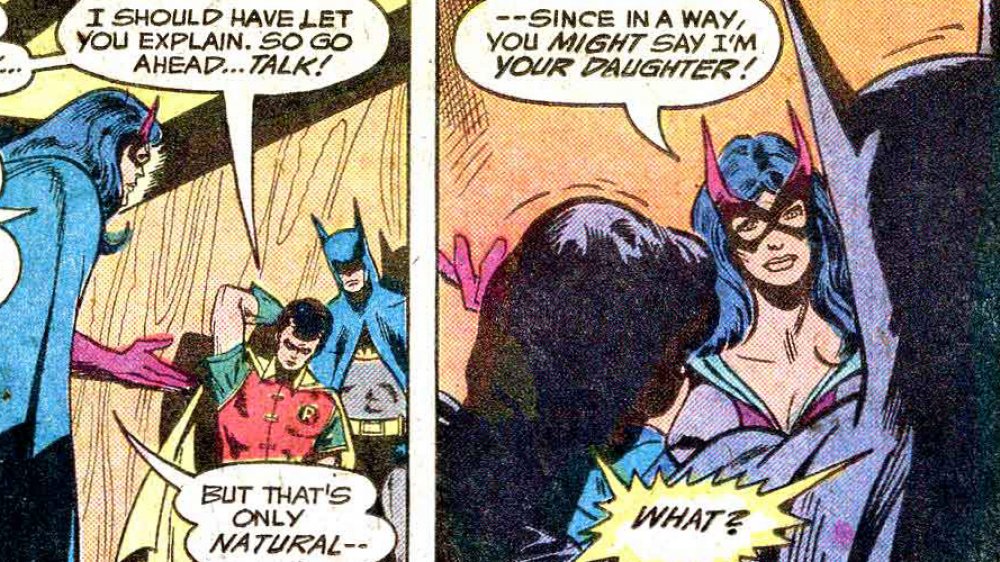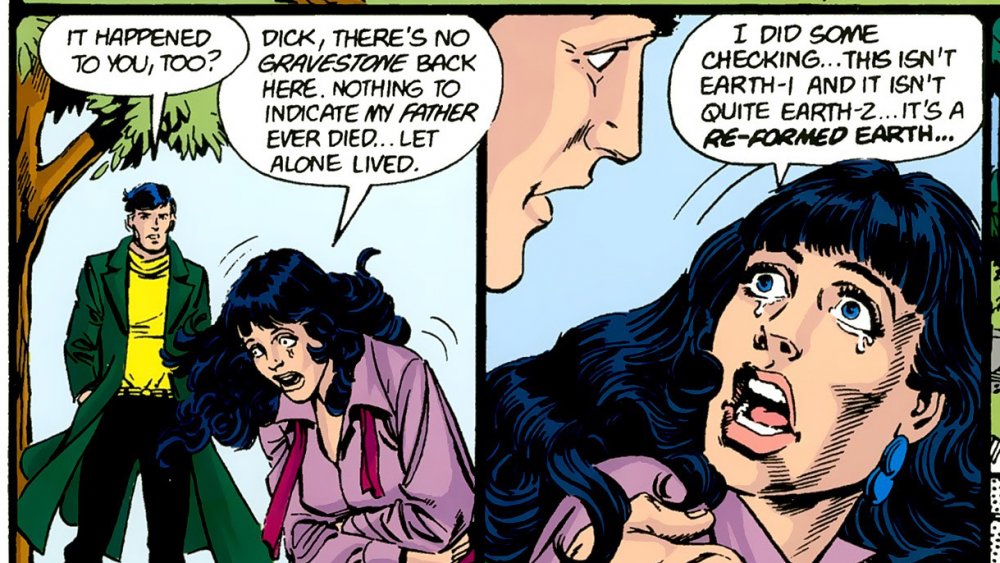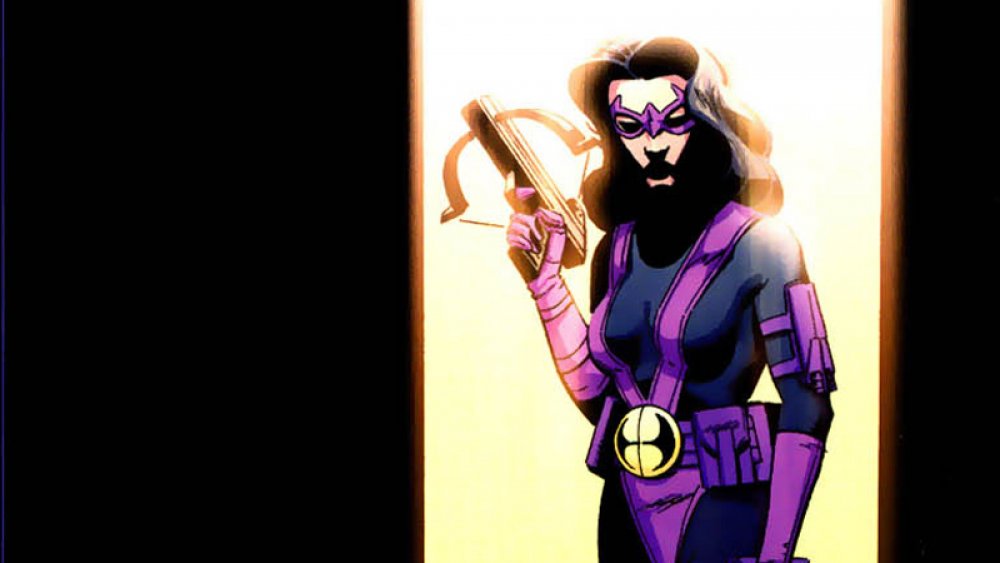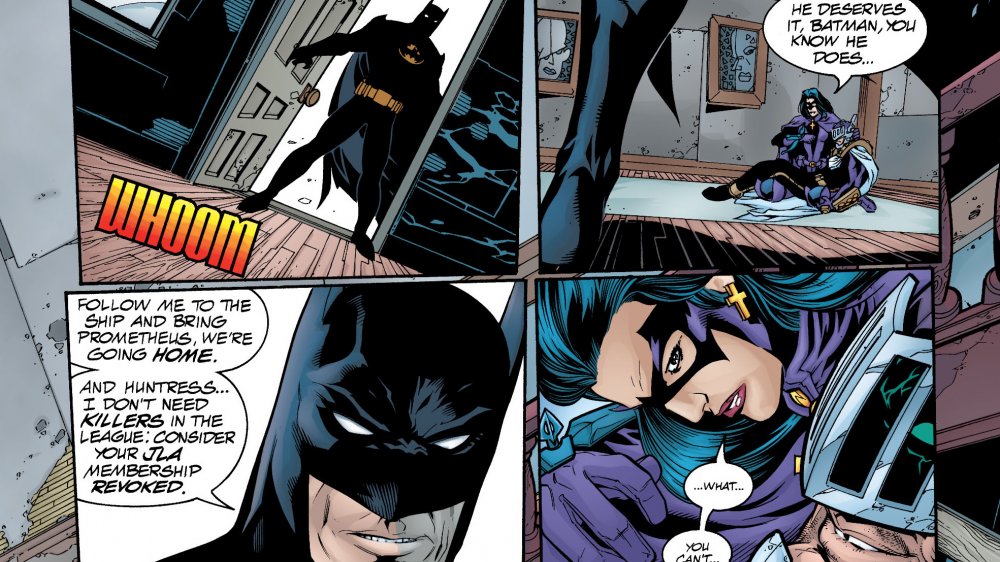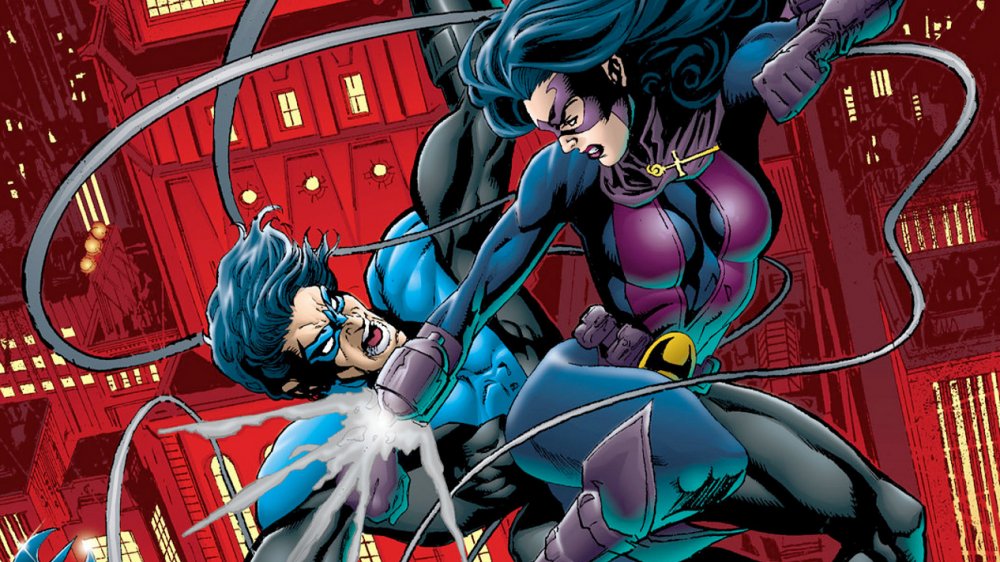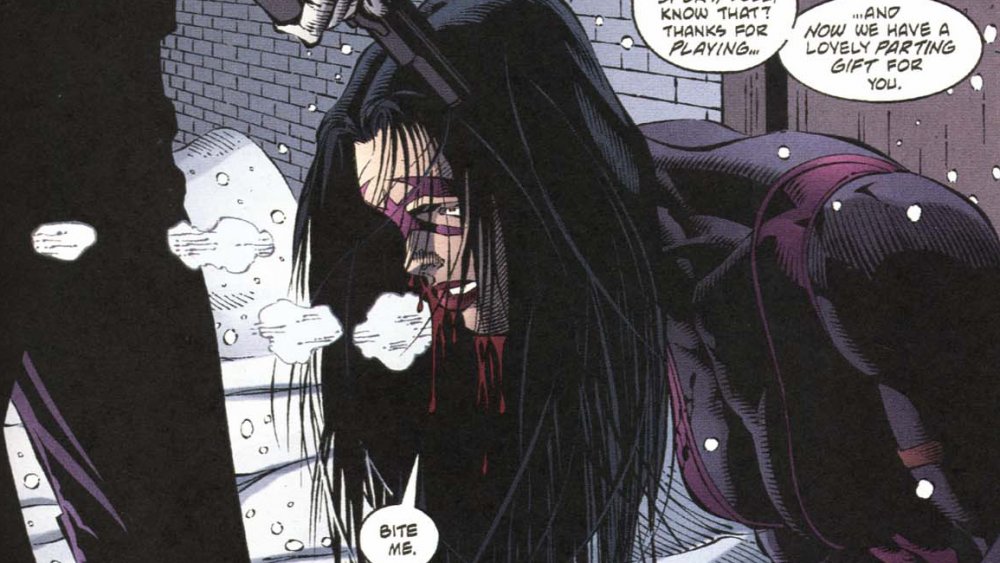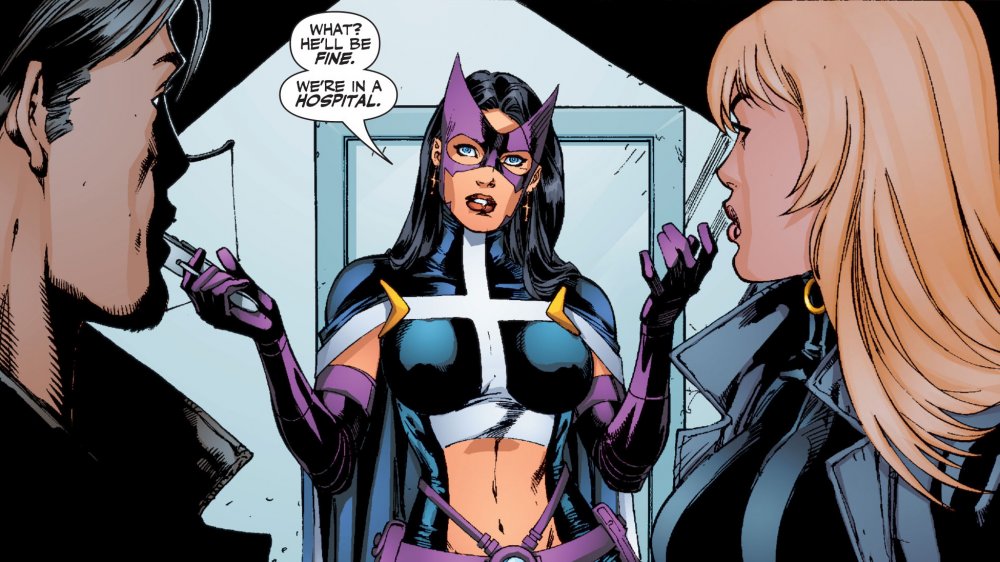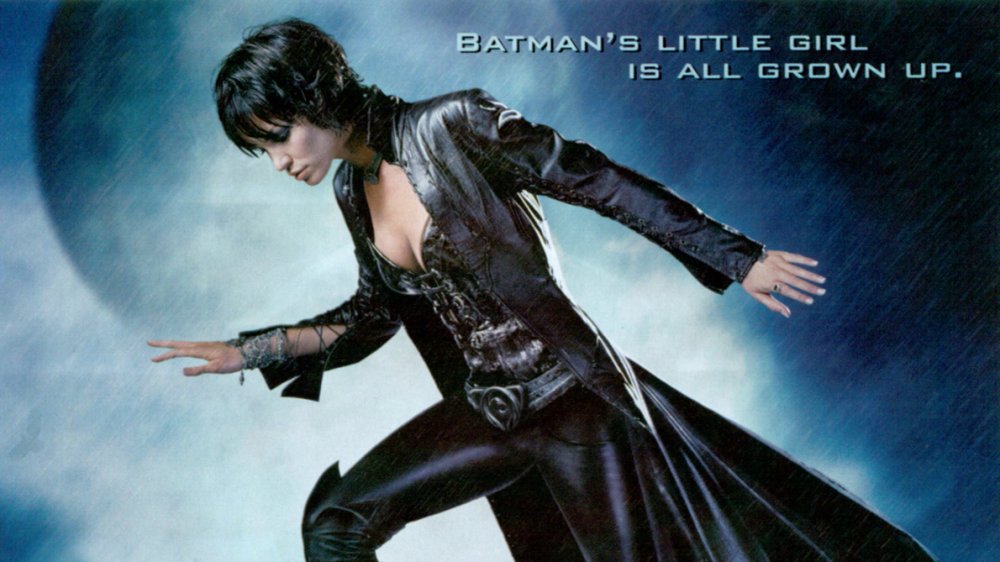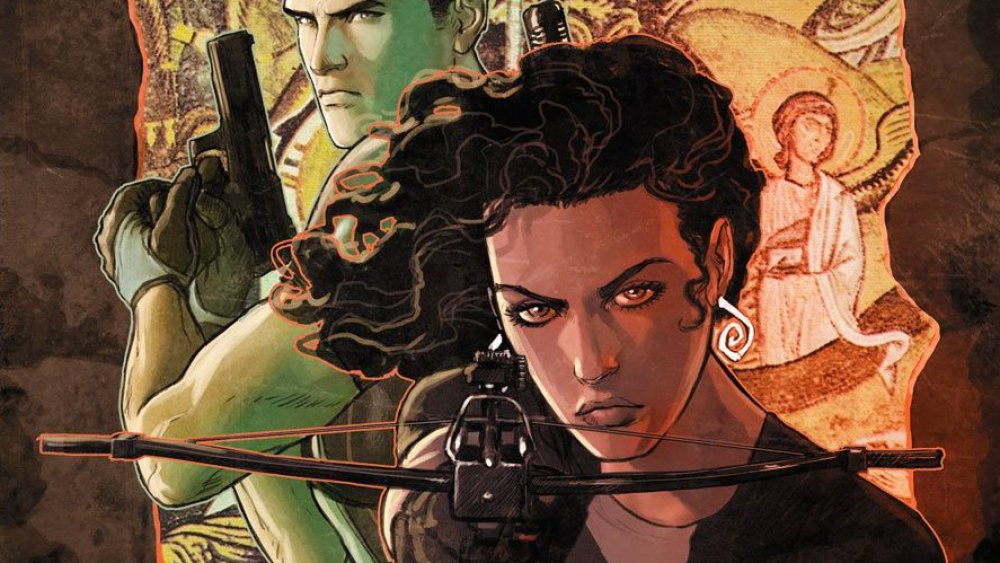The Untold Truth Of Huntress
Every now and then, a superhero universe will rearrange itself, and characters will be wiped out of existence, never to be spoken of again. Sometimes, however, those characters are built on such strong ideas, iconic imagery, and well-crafted stories that they make their way back into the world, carving out a new place in the canon.
The Huntress is one of those characters. Originally introduced as the daughter of Batman and Catwoman, she was positioned as a major character in DC's multiverse, but was killed off and retconned out of existence. Still, she made her way back not once, but twice, as a complex character in her own right that went far beyond just a heroic lineage. Now, she's set to make her big screen debut in Birds of Prey. If you're curious how she went from the next generation of Gotham City's first family to a vigilante mafia princess to a deadly super-spy and back again, here's the truth about the Huntress.
The Earth-2 origins of Huntress
If you really want to understand the Huntress, you have to understand Earth-2, and how an attempt to solve a storytelling problem that ultimately didn't matter gave DC Comics the chance to take their characters in some very unexpected directions.
The basic idea was this: in the 1950s, DC decided they needed to explain things like how Superman and Batman could've been around since the late '30s without ever seeming to get any older, and why there were new characters like the Flash and Green Lantern who seemed to be completely unrelated to the characters with the same names who had been around during the first big superhero boom in the '40s. The solution was, of course, to dive headfirst into the idea of parallel Earths. In the pages of Flash, the idea of Earth-2 was created as a home for all of the DC Universe's original characters.
The main effect of Earth-2 was that it cleared up a few continuity headaches — like Superman being named Kal-L instead of Kal-El and working at the Daily Star instead of the Daily Planet in his first appearance, and Batman using guns during his first year of stories. Of course, it also created a few new headaches, like how some of the Earth-2 heroes existed as fictional comic book characters on Earth-1. Barry Allen chose to name himself "The Flash" because he'd read comics about the original Flash as a kid, for example, but apparently nobody ever bothered to read the ones about how Batman was Bruce Wayne and Superman was Clark Kent. Really, though, it wasn't as complicated as it sounds, and allowed for some really interesting things to happen down the line.
Batman: The Next Generation
One of the most interesting aspects of Earth-2 was that it gave DC versions of its most popular characters that could change in ways that the ones in the main stories never could. While the core versions of Batman, Superman, and Wonder Woman were tied to the present and bound to a certain status quo, the Earth-2 versions were allowed to grow older and change. Earth-2 Superman, for instance, was happily married to Lois Lane, even with his Earth-1 counterpart still refusing to settle down while he waged his never-ending battle against evil.
The same went for the Batman family. Dick Grayson grew up, keeping his identity as Robin into adulthood after Bruce Wayne retired from crime-fighting and married Selina Kyle, better known as Catwoman. Earth-2's version of Bruce Wayne would even die, prompting an elderly Joker to go on a rampage after being denied a final clash with his arch-nemesis. Long before that, however, Bruce and Selina had a child together named Helena Wayne.
As you might expect, Helena joined up with the family business, taking the name Huntress and sporting a costume that combined Batman's pointy-eared look with Catwoman's traditional purple aesthetic. What might be surprising, though, is that she wasn't all that prominent as a character, only making rare appearances. It's not exactly what you'd expect from a character with that lineage, but the story wasn't over yet.
"Uncle Bruce"
While the original Huntress fought crime alongside the grown-up Robin as the "New Dynamic Duo," Helena Wayne's most prominent appearances came when she took an interdimensional vacation to Earth-1 to spend some time with that dimension's version of her dad. Of course, meeting up with your alternate reality daughter who doesn't exist in your timeline is always going to be a little weird — especially when you find out that her mom is the cat-themed supervillain who tried to drown you in a jaguar cage a few weeks ago — but, you know. It's the DC Universe. You get used to stuff like that.
In addition to teaming up with "Uncle Bruce" over Christmas and clearing the Wayne family name after Batman's dad was framed for crimes, the Huntress also faced off against the Earth-1 counterpart of her own mother. That fight was particularly fraught for Helena, since it was the death of Earth-2's Catwoman that inspired her to take up crime fighting for herself. In the end, though, she declared that while the main timeline's Catwoman had the potential to reform, "until then, you're just another criminal!" Try using that one on your own family next time an argument breaks out over Thanksgiving, and let us know how it goes.
Crisis claims the Huntress
In the mid '80s, DC restructured their universe through a massive, 12-issue event called Crisis on Infinite Earths. The tagline for the series claimed that "worlds will live, worlds will die, and the DC Universe will never be the same," and while comic book covers have featured over-the-top promises for as long as there have been comics to cover, this one actually lived up to its promise.
There were a lot of high profile shake-ups in Crisis, including the death of Barry Allen and Supergirl being both killed and wiped out of existence, but the Huntress was one of many characters who were consigned to limbo as a result of the events. The main effect of the story was that the Multiverse of parallel worlds — not just Earth-1 and Earth-2, but Earth 3, S, X, C, C-minus (no, really), and so on — were obliterated and streamlined into a single unified timeline. As a result, there was no more Earth-2 Batman, because there was no more Earth-2 to be the Batman of. If Earth-2 didn't exist, then neither did Helena Wayne.
It's worth noting that Huntress was one of the few characters to survive the initial destruction of her home dimension, finding herself stranded alongside Earth-2's Robin on a strange world with no record of her existence. With nothing left for her in the universe — a pretty depressing proposition — she joined Robin on what seemed like a suicide mission, battling the forces of the Anti-Monitor as they invaded the new Earth in an attempt to destroy it. The final indignity? The story specifically states that her body — and Robin's — were never found after their deaths.
Helena Bertinelli: The All-New Huntress
Here's the thing about superhero comics: nothing ever really goes away, especially when it's something as intrinsically tied to a major character as, say, Batman's daughter. With that in mind, it's no surprise that DC brought back the Huntress only a few years after Crisis. What is surprising is that they completely reinvented the character in almost every aspect, aside from her costume and her first name — and even the costume underwent some radical changes before too long.
Instead of being Batman's daughter, the post-Crisis Huntress was something a little closer to being DC's take on the Punisher. Helena Bertinelli was the youngest member of one of Gotham City's most prominent crime families in the years before Batman arrived and organized crime gave way to clowns trying to poison the reservoir and mad biologists shooting everyone with ice guns. When she was only eight years old, Helena's entire family was murdered in front of her by a hitman who left her alive.
Helena was taken in by her family in Sicily, who offered to train her so that she could get her revenge, something that she took to very well. When she returned to Gotham, however, she saw Batman in action, and realized that if she really wanted to strike terror into the hearts of the mobsters who had targeted her family, she should follow in his footsteps as a vigilante. With that, she took the identity of the Huntress, although that wasn't her only calling. While she was wealthy enough to live off of her family's ill-gotten gains, she actually kept a day job as a school teacher, something that would have more prominence in other versions of the character.
Standards and practices
You don't really get to be a vigilante in Gotham City without attracting some attention from, well, the vigilante in Gotham City. Sure enough, it wasn't long before the Huntress encountered Batman.
The big sticking point between the two characters was that while Batman famously refuses to kill his enemies (in most stories, anyway), the Huntress has no problem at all sending her opponents off to their final reward. Still, Batman didn't set out to take the Huntress down. After all, if there's one person who understands the intense trauma of watching your family get gunned down in front of you, and the intense anger that can lead you to put on a cape and wage war against all criminals by night, it's that guy. Still, he didn't approve of her methods, but the solution he came up with for this problem wasn't the one that anyone expected. He let her join the Justice League.
Batman's hope was that membership in the JLA, surrounded by paragons of virtue like Superman and Wonder Woman, would be a good influence on the Huntress and show her a different way of fighting crime. It did not work. When Batman found her getting ready to execute a helpless supervillain at the climax of one of the League's biggest crises, he booted her out of the league in disappointment.
The black sheep of the Batman family
Helena Bertinelli's relationship with the rest of the Batman family is... complicated. We've already been through her rocky interactions with the Dark Knight himself, but his sidekicks tend to have a very different perspective on the Huntress. Tim Drake, for instance, has the sort of relationship you'd expect from a super-smart teenage overachiever and a world-weary teacher, and Dick Grayson has... well, exactly the same relationship that you'd expect from him, too.
On the off chance that you're not keyed in to the complex web of relationships that is the love lives of DC Comics characters, Nightwing is basically the most eligible bachelor in the entire universe. He's got the same dedication to physical perfection as Batman, except he's a gymnast who has dealt with his trauma in a (relatively) healthy way and is actually friendly and caring. He's a catch, is what we're getting at here.
When he first encountered the Huntress, they had immediate chemistry, and they quickly found themselves in a team-up with benefits. According to an interview with writer Devin Grayson from around the time that Nightwing/Huntress came out, the idea was that these where characters for whom physicality was a central part of their characters, which meant they were going to express themselves physically when they felt that connection. An actual relationship didn't blossom out of that encounter, though — neither of the characters were ever depicted as expecting it to, although at least part of it was because of the time that Huntress accidentally shot Batman with a crossbow in front of Nightwing. There are definitely exceptions, but using medieval weaponry on someone's beloved father figure is often going to be a dealbreaker.
Batgirls and bullets
Even more than Batman himself, Helena Bertinelli's most complicated relationship within the Dark Knight's group of assorted sidekicks and hangers-on was with Barbara Gordon — and before you start wondering, it actually had very little to do with Barbara's on-again, off-again relationship with Dick Grayson.
Instead, the biggest source of conflict came from what was essentially the superheroic equivalent of copyright infringement. It happened in No Man's Land, a year-long crossover event where a cataclysmic earthquake left Gotham City apocalyptically devastated and abandoned by a government that was willing to write off their most crime-ridden city rather than rebuild it. After unsuccessfully campaigning to save the city, Bruce Wayne was left dejected and depressed, and even contemplated abandoning the city himself, leaving it for three months even while others — like Barbara herself, along with Jim Gordon and much of the GCPD — stayed to try to keep unchecked supervillains from carving the city into their own little Fury Road territories.
While Batman was gone, a mysterious new Bat-person appeared, who eventually turned out to be the Huntress, using Batman's identity and iconography to give hope to the remaining citizens. When Batman returned, he gave her his approval to continue acting as the ersatz Bagirl, which didn't sit well with Barbara. Babs had been forced to give up being Batgirl after being paralyzed by the Joker, and the idea of Batman giving away something that she still thought of as a big part of her identity without even telling her who was under the mask infuriated her.
Eventually, around the same time that she was fired from the JLA, Huntress gave up the Batgirl identity voluntarily, but No Man's Land also provided her with a measure of redemption for what Batman had seen as her failings. When the Joker launched an attempt to murder every baby born in Gotham during the NML year — easily one of his most sinister crimes ever — Huntress made a heroic last stand to protect them, fighting a small army of Joker impostors, and was shot five times in the process.
Birds of Prey
After the injuries she suffered in No Man's Land, Helena Bertinelli made a full recovery, and so did her relationship with Barbara Gordon... for a while. As Oracle, Barbara had become an information broker for the superhero community, using her incredible intelligence and hacking skills to guide heroes on their missions. She also founded a team of her own called the Birds of Prey — a name that was used as the title of her comic for years before it became the official name of her team — primarily working with other heroines, sending them on missions as her operatives.
Oracle's most long-tenured partner in the Birds of Prey was Black Canary, but having felt aimless for years after her experiences in No Man's Land, the Huntress joined up as well. The camaraderie of the team seemed to be doing a lot of good for Helena, allowing her to move past the anger and desire for revenge that had driven her since she was a child. Unfortunately, it was short lived. After a few adventures with the Birds, she realized that Oracle had been specifically sending her on missions designed to teach her lessons and force her to confront her past and move towards self-improvement, treating her the same way that a teacher would handle a problem student. Infuriated at being manipulated by yet another member of the Batman family who seemed to want to mold her into what they wanted her to be, she ditched the team and left.
For a while, it seemed like she'd taken up the family business, reclaiming her spot at the head of Gotham City's crime families as the rightful heir of the Bertinellis, but it turned out that she was using her connections to achieve her goals in a different way. She'd ascended to the top of Gotham's mobs as an undercover operation, and once she had all the information needed to break their hold on the city, she handed it over to Batman.
Live action Birds of Prey, Take One
In 2002, around the same time that Helena Bertinelli was going through her most intense period of character development from No Man's Land to Birds of Prey to Batman/Huntress: Cry for Blood (an expanded, detailed origin story and character study that contrasted her with the Question), the idea behind the original Huntress made a surprising, albeit extremely short-lived return.
That year, the WB, one of the networks that would combine to form the CW, launched a Birds of Prey TV show, loosely — and that's the key word there — based on comic of the same name, focused on two lead heroines. The first was Barbara Gordon, played by Dina Meyer, who, like her comic book counterpart of the time, had been Batgirl until she was shot by the Joker, and had reinvented herself as Oracle. The second, as though things weren't complicated enough already, was Helena Kyle. Like the original Earth-2 Huntress, she was the daughter of Batman and Catwoman, heavily implied to be the versions seen on the big screen in Batman Returns. Unlike Helena Wayne, however, this version never knew her father, with Catwoman keeping her birth a secret from Batman. Still, after Batman's death and apparent abandonment of the City, she took the identity of the Huntress and carried on his legacy alongside Barbara.
The show only lasted a single 13-episode season before it was canceled, largely because — to be completely honest — it was not very good. It did have some interesting ideas, however, especially with regards to how it combined two characters drawn from very different eras of DC comics. It wasn't entirely forgotten, either — 17 years after the last episode aired, Ashley Scott returned to the role of the Huntress for the CW's Crisis on Infinite Earths crossover.
Double the Huntress
In 2011, DC revamped their universe once again as "The New 52." It has, of course, mostly been completely undone over the past decade, but at the time, it was a clean break from everything that existed, where plenty of characters were wiped out of continuity and some were completely altered. With that in mind, Huntress fans were left with the question of just which version of the character they'd get from the new DC Universe: Helena Wayne or Helena Bertinelli? Well, as a very wise person once said, porque no los dos?
One of the big changes to the New 52 was the return of the idea of Earth-2, but with a big twist. Rather than being the home of characters like the original Green Lantern and Flash, Alan Scott and Jay Garrick, who had existed before their modern incarnations, it was a world where Superman, Batman, and Wonder Woman had all gotten started just like they had in the regular DC Universe... except that they were all killed shortly thereafter, paving the way for a second generation of heroes to take up their legacies. In that reality, Helena Wayne had fought alongside her father as Robin, and wound up being stranded on DC's Prime Earth — the regular continuity — where she took up the identity of the huntress.
Meanwhile, when Nightwing had his identity revealed and was apparently killed, Dick Grayson joined up with an international espionage organization called Spyral, where he encountered a woman with a very familiar sense of fashion and love of crossbows. This was Helena Bertinelli, who at the time was using the codename Matron as the head of a girls' boarding school meant to train young women as spies. Eventually, she took over leadership of Spyral, taking the codename Huntress — a very different version of Helena Bertinelli with the same crime family origin.
